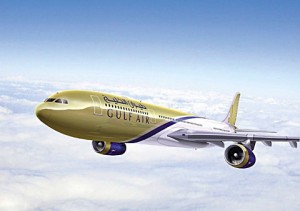 Powered by a private cloud, Gulf Air, the principal carrier of Bahrain, has been able to transform itself into a dynamic airline that provides better service to its passengers while minimising short-term and long-term IT infrastructure costs.
Powered by a private cloud, Gulf Air, the principal carrier of Bahrain, has been able to transform itself into a dynamic airline that provides better service to its passengers while minimising short-term and long-term IT infrastructure costs.
In today’s extremely competitive market, airlines live and die by their IT systems. Their IT infrastructure must combine performance and availability with functionality and efficiency – and the customer experience is everything. And when you are one of the world’s longest operating airlines – Gulf Air- the challenge is to ensure this experience brings together a variety of products seamlessly and fast. Downtime just isn’t an option.
Gulf Air, which has been in business for more than 62 years and fly to 53 destinations, started computing way back in the late 70s. The airline has around 5000 IT users including pilots, cabin crew and has offices spread across 80 countries.
Airline applications are typically very complex and expensive, and require a large infrastructure and team of experts. “Gulf Air has been doing computing for 40 plus years and we had two data centres, which were consolidated into one. In this business, customers’ needs are changing rapidly and we are always exploring new ways of doing business smartly,” says Dr.Jassim Haji, Director of IT.
The airline has around 150 applications running on its network, some hosted and some managed in-house. The most critical ones include the reservation systems from Sabre, cargo systems, Oracle e-business suite and revenue management systems. “The real challenge is getting to interface these applications and get them to talk to each other. Over the last few years, we have continuously refreshed all our applications with a best of breed approach. We are making sure that instead of being an operations support entity we are going to evolve as a customer-centric IT service provider and equip our internal users with tools to better serve our customers,” says Haji.
Faced with the challenge of accommodating legacy systems with the newly introduced systems without compromising levels of IT services, Gulf Air embarked on its cloud journey a year and half back. The choice was between private and public cloud, and Haji zeroed in on the former to improve business efficiency and lower IT costs while introducing new services.
“Public cloud is probably a quick solutions but it is not really an option for bigger organisations like ours because of the legal and security issues. Private cloud was the right choice for us as it addresses security concerns and migration to public cloud would have been very challenging. Another issue is that the public service provider gradually takes over your infrastructure and there is no way you can roll it back in if you want to do so bit later. You are left with no platform to maintain by yourself, “ says Haji explaining the logic behind the decision to go private.
Gulf Air’s cloud journey started with two virtualised server running around 5-6 applications each and now the airline has achieved around 90 percent virtualisation with even mission-critical applications running on VMs.
Cloud computing proved to be a successful strategy that helped Gulf Air accomplish many achievements over the last 18 months. As a result, the company has been able to reduce its physical server count by 35 percent, shrinking the number from 150 to now just two racks of blade servers, running different flavours of virtualisation. “Some of our servers were coming to end of life and this would have meant investing in more servers. Virtualisation enabled us to avoid that cost,” says Haji.
Just like with applications, Haji has adopted a best of breed approach to virtualisation as well, with VMware used for server virtualisation, Oracle for database virtualisation, EMC for storage and Citrix for desktop virtualisation.
He says the average age of server infrastructure has been reduced by 70 percent to 3 years with virtualisation and has enabled the retirement of old platforms. Server utilisation levels have also increased significantly, which was hovering around 30 percent and as a result of storage virtualisaiton, Gulf Air has also been able to optimise its storage infrastructure and free up lot of data storage space.
Cloud hasn’t been just about cost savings for Gulf Air, and Haji says it has helped his team to get better visibility and control of the network. “In the old days, you had to depend on external service providers for things like reservation. “It cost you a lot and you couldn’t control how you access the reservation system. We turned it around by building a private network, where we can bring in a link from the service provider to the cloud and then we distribute it to wherever we want,” says Haji.
Another offshoot of cloud for Gulf Air has been DR. “We are in the process of setting up a DR site connected through the cloud that will enable us to have real-time replication and backup. We have already selected a bunch of applications for DR and we will add more as we go along,“ says Haji.
Mobility is another key theme at Gulf Air. The cloud platform has allowed it the flexibility to offer core services via mobile including flight search, check-in, boarding passes and flight status notification. Gulf Air, says Haji, is one of the first airlines in the world to adopt a private cloud strategy and the company has reaped rich dividends, not just in the form of reduced capital expenditure but also its ability to provide superior service to its customers, regardless of the location.





